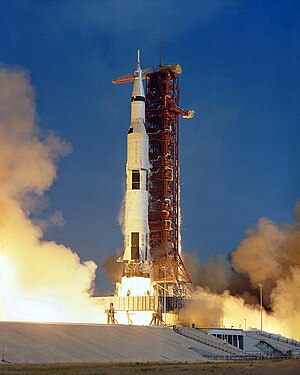Template talk:POTD/2019-07-16
Draft alternative version[edit]

|
A Saturn V rocket carrying Apollo 11, the first crewed lunar landing mission, on July 16, 1969, at 13:32 UTC. Launching from Launch Pad 39A at Florida's Kennedy Space Center, the five Rocketdyne F-1 engines of the rocket's S-IC first stage can be seen arrayed in a quincunx, with a fixed center engine and four outer engines that gimballed for steering. A multistage liquid-fuel expendable rocket, the Saturn V was designed under the direction of Wernher von Braun at the Marshall Space Flight Center. It was the largest production model of the Saturn family, with a height of 111 m (363 ft), although larger models were theorized. The super heavy-lift launch vehicle consisted of liquid-propellant rockets in three stages, the first of which had a total mass at launch of 2.3 million kilograms (5.1 million pounds), consisting mostly of its RP-1 fuel and liquid oxygen. As well as launching Apollo missions, the Saturn V also launched the Skylab space station. Thirteen rockets were launched from 1967 to 1973, with an almost perfect launch record – Apollo 6 and Apollo 13 did lose engines, but the onboard computers were able to compensate. Photograph credit: NASA; retouched by PawełMM
Recently featured:
|
